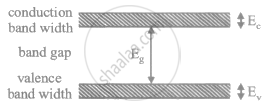Advertisements
Advertisements
प्रश्न
When a semiconducting material is doped with an impurity, new acceptor levels are created. In a particular thermal collision, a valence electron receives an energy equal to 2kT and just reaches one of the acceptor levels. Assuming that the energy of the electron was at the top edge of the valence band and that the temperature T is equal to 300 K, find the energy of the acceptor levels above the valence band.
उत्तर
Before the thermal excitation, the electron was located at the top of the valence band.
After the thermal excitation, the electron was present in the acceptor level.
This implies that the energy gap between the valence band and the acceptor level is equal to the energy absorbed by the electron in thermal excitation.
Thus,
2kT = Energy gap between the acceptor level and the valence band
\[\Rightarrow E = 2 \times 1 . 38 \times {10}^{- 23} \times 300 \]
\[ \Rightarrow E = (2 \times 1 . 38 \times 3) \times {10}^{- 21} \] J
\[ \Rightarrow E = \left( \frac{6 \times 1 . 38}{1 . 6} \right) \times \frac{{10}^{- 21}}{{10}^{- 19}} \] eV
\[ \Rightarrow E = \left( \frac{6 \times 1 . 38}{1 . 6} \right) \times {10}^{- 2} \]eV
\[ \Rightarrow E = 5 . 175 \times {10}^{- 2} \] eV
\[ \Rightarrow E = 51 . 75 \] meV
APPEARS IN
संबंधित प्रश्न
Write two characteristic features to distinguish between n-type and p-type semiconductors ?
What is the resistance of an intrinsic semiconductor at 0 K?
Electric conduction in a semiconductor takes place due to
When an impurity is doped into an intrinsic semiconductor, the conductivity of the semiconductor
In a transistor,
In a semiconductor,
(a) there are no free electrons at 0 K
(b) there are no free electrons at any temperature
(c) the number of free electrons increases with temperature
(d) the number of free electrons is less than that in a conductor.
The electrical conductivity of pure germanium can be increased by
(a) increasing the temperature
(b) doping acceptor impurities
(c) doping donor impurities
(d) irradiating ultraviolet light on it.
The band gap for silicon is 1.1 eV. (a) Find the ratio of the band gap to kT for silicon at room temperature 300 K. (b) At what temperature does this ratio become one tents of the value at 300 K? (Silicon will not retain its structure at these high temperatures.)
(Use Planck constant h = 4.14 × 10-15 eV-s, Boltzmann constant k = 8·62 × 10-5 eV/K.)
The band gap between the valence and the conduction bands in zinc oxide (ZnO) is 3.2 eV. Suppose an electron in the conduction band combines with a hole in the valence band and the excess energy is released in the form of electromagnetic radiation. Find the maximum wavelength that can be emitted in this process.
Suppose the energy liberated in the recombination of a hole-electron pair is converted into electromagnetic radiation. If the maximum wavelength emitted is 820 nm, what is the band gap?
(Use Planck constant h = 4.14 × 10-15 eV-s, Boltzmann constant k = 8·62 × 10-5 eV/K.)
The conductivity of an intrinsic semiconductor depends on temperature as σ = σ0e−ΔE/2kT, where σ0 is a constant. Find the temperature at which the conductivity of an intrinsic germanium semiconductor will be double of its value at T = 300 K. Assume that the gap for germanium is 0.650 eV and remains constant as the temperature is increased.
(Use Planck constant h = 4.14 × 10-15 eV-s, Boltzmann constant k = 8·62 × 10-5 eV/K.)
Hydrogen atom in n = 3 state has a lifetime of 10-10 sec. The number of revolutions an electron makes in the n = 3 state before returning to the ground state is ______.
Useful data
`1/(4pi∈_0) = 8.99 xx 10^-34`N m2 C-2; e = 1.60 10-19 C; h = 6.63 10-34 Js; me = 9 × 10-3 kg
If the lattice constant of this semiconductor is decreased, then which of the following is correct?

In a common-base circuit calculate the change in the base current if that in the emitter current is αmA and a = 0.98
In a common base configuration Ie = 1 mA α = 0.95 the value of base current is
The reaction between α and β parameter of a transistor is given by
- Assertion (A): In insulators, the forbidden gap is very large.
- Reason (R): The valence electrons in an atom of an insulator are very tightly bound to the nucleus.
Which one of the following elements will require the highest energy to take out an electron from them?
Pb, Ge, C and Si
With reference to semiconductor physics, answer the following question.
What is meant by “Forbidden band" of energy levels?
